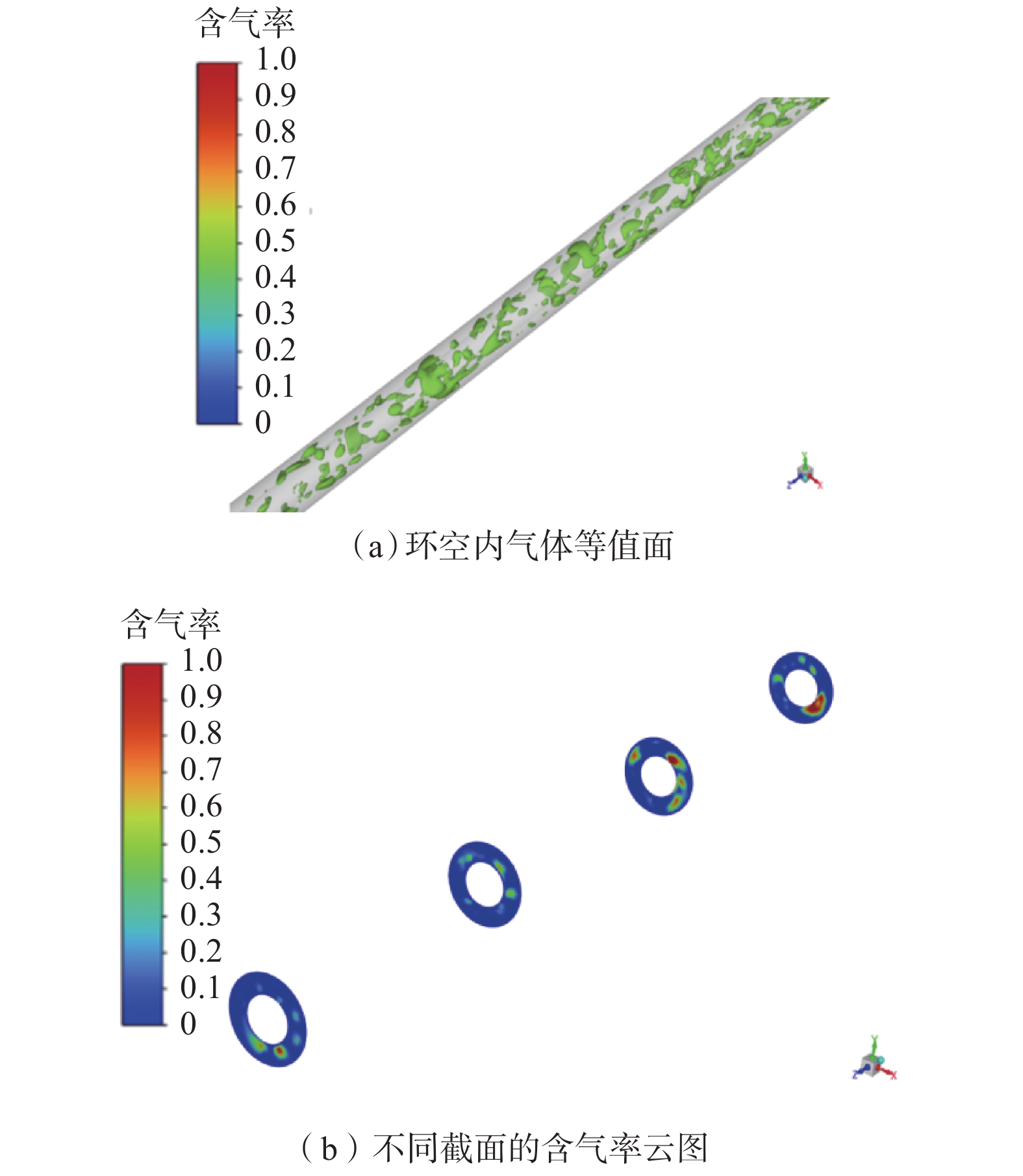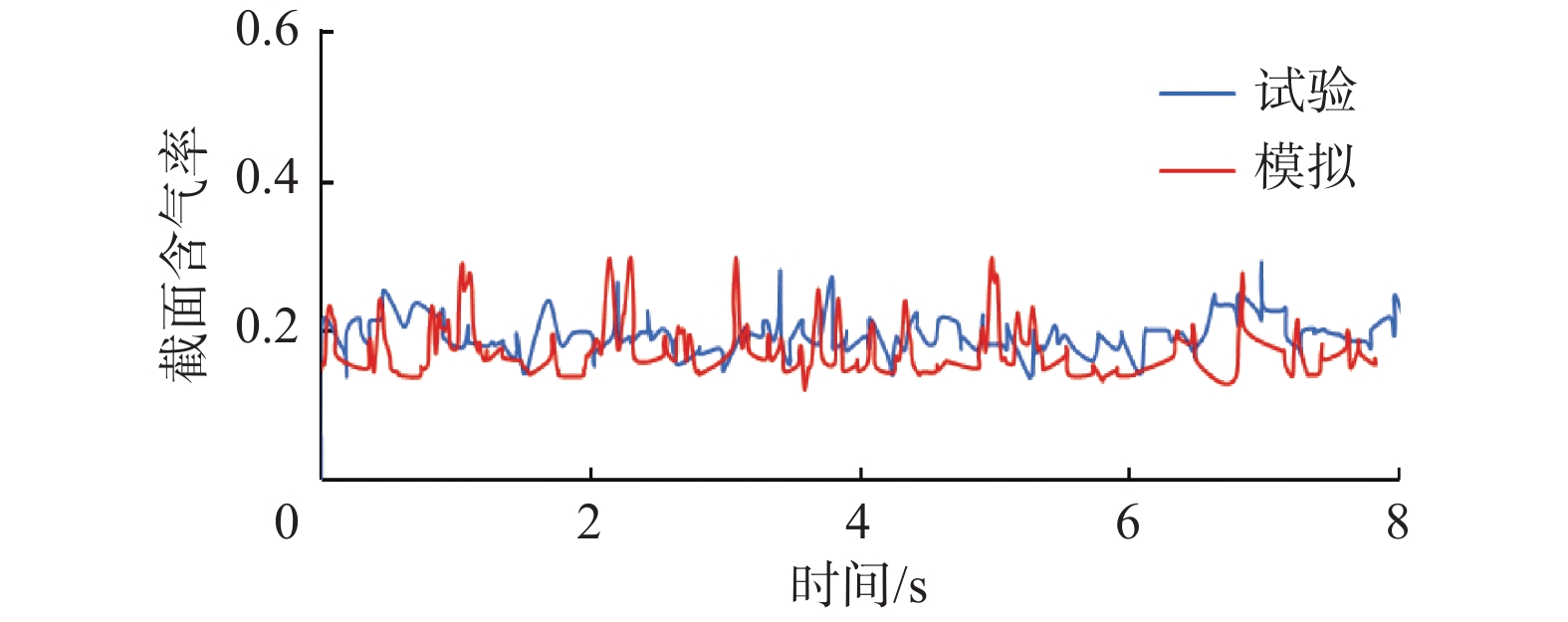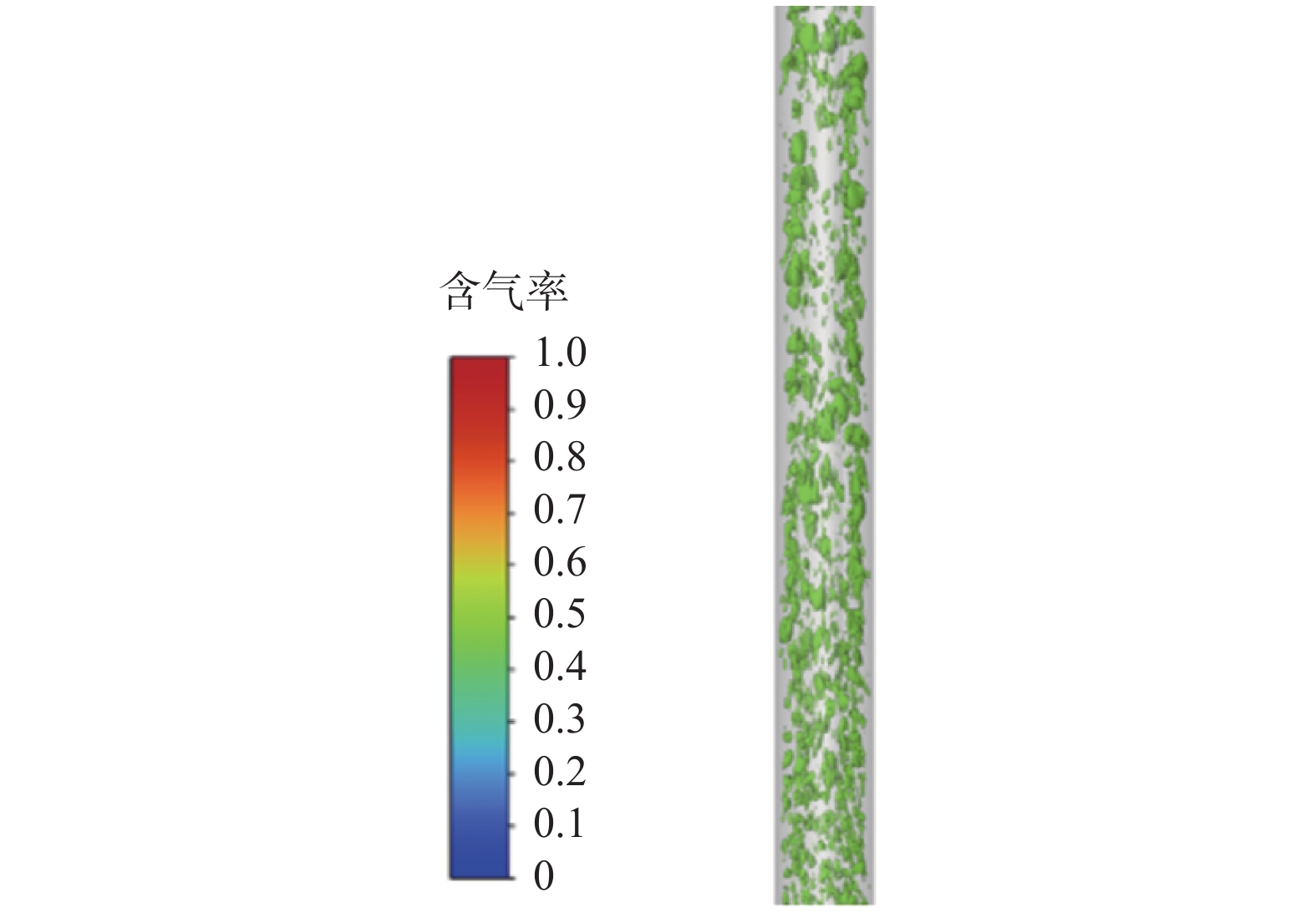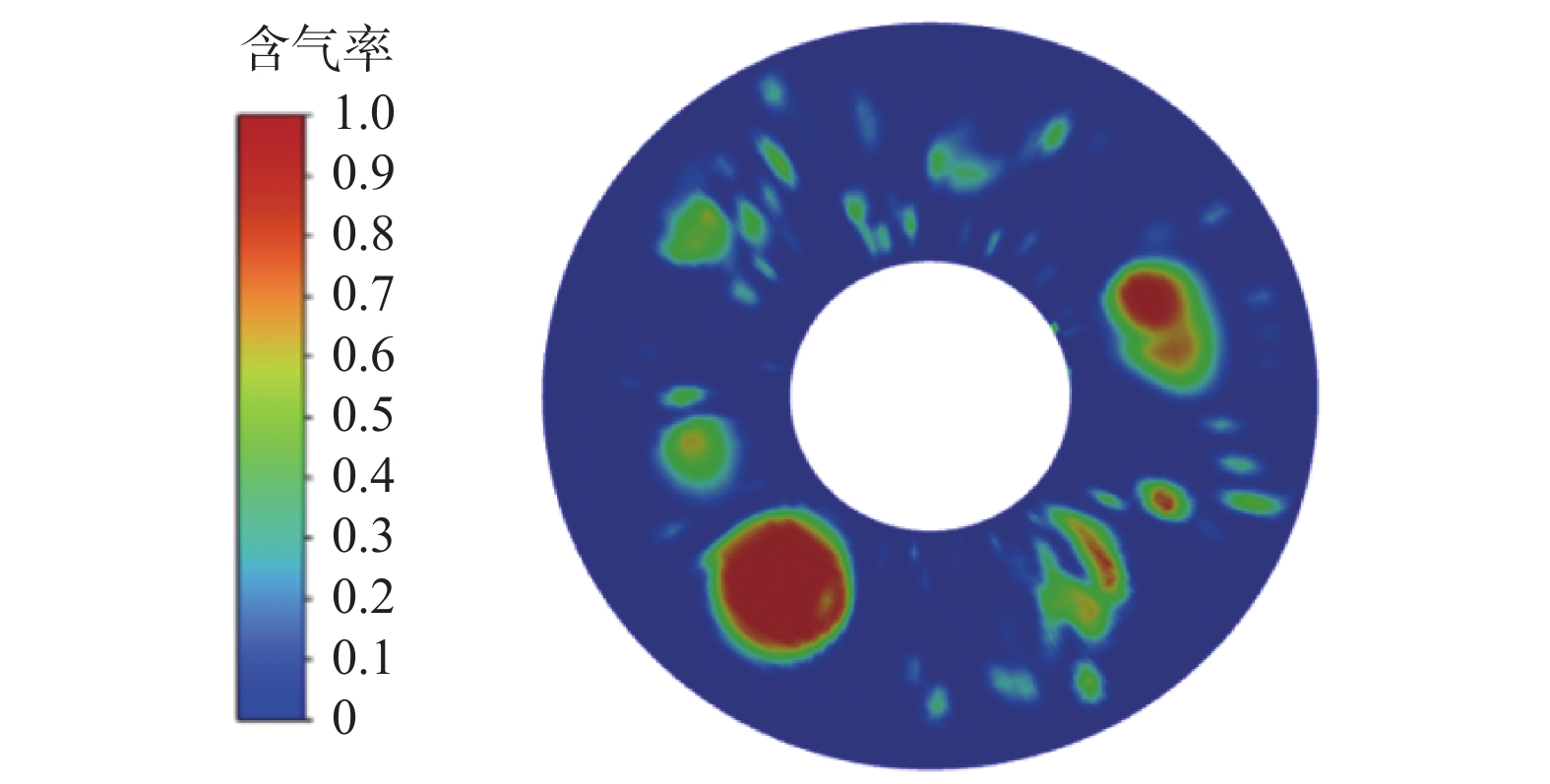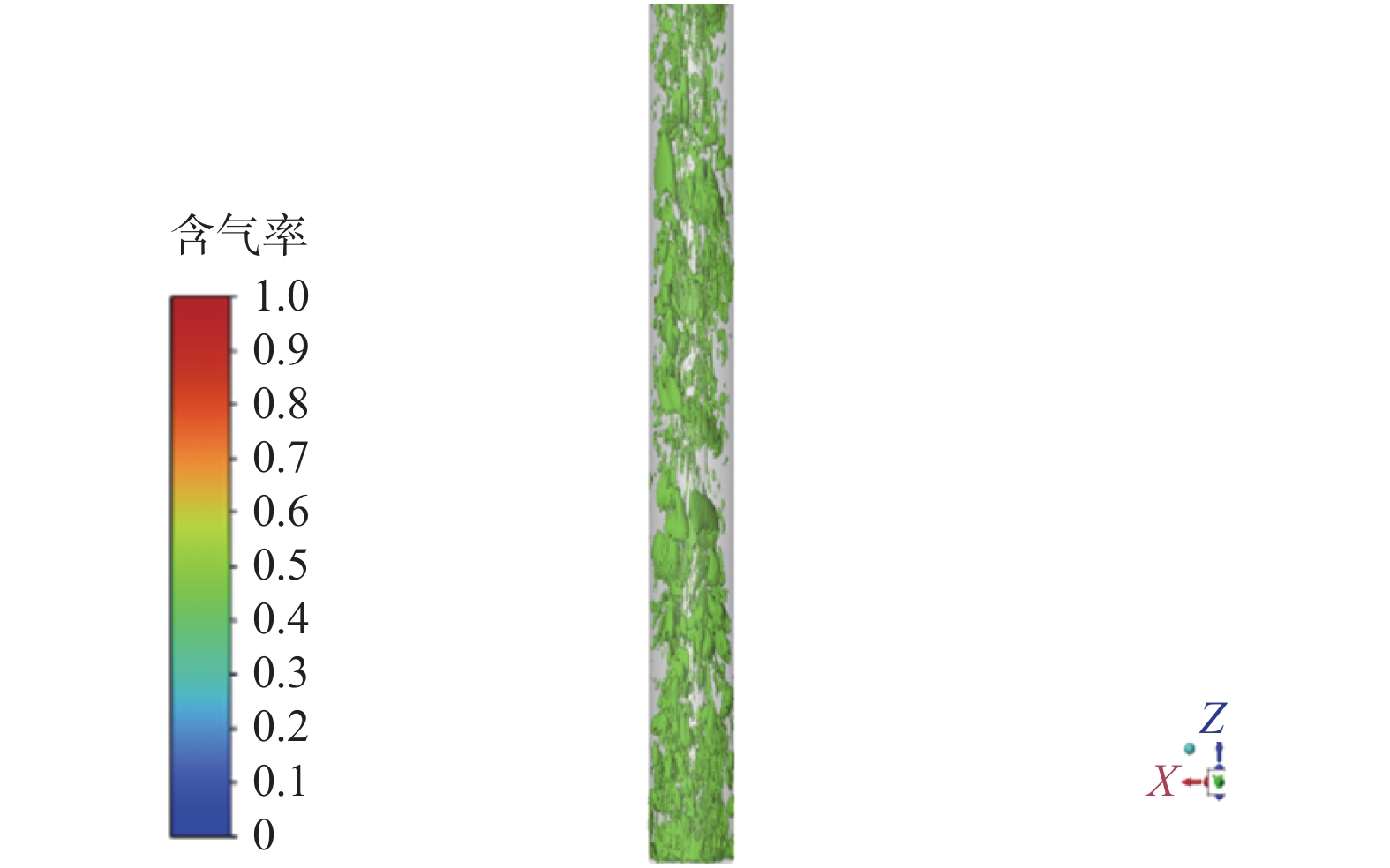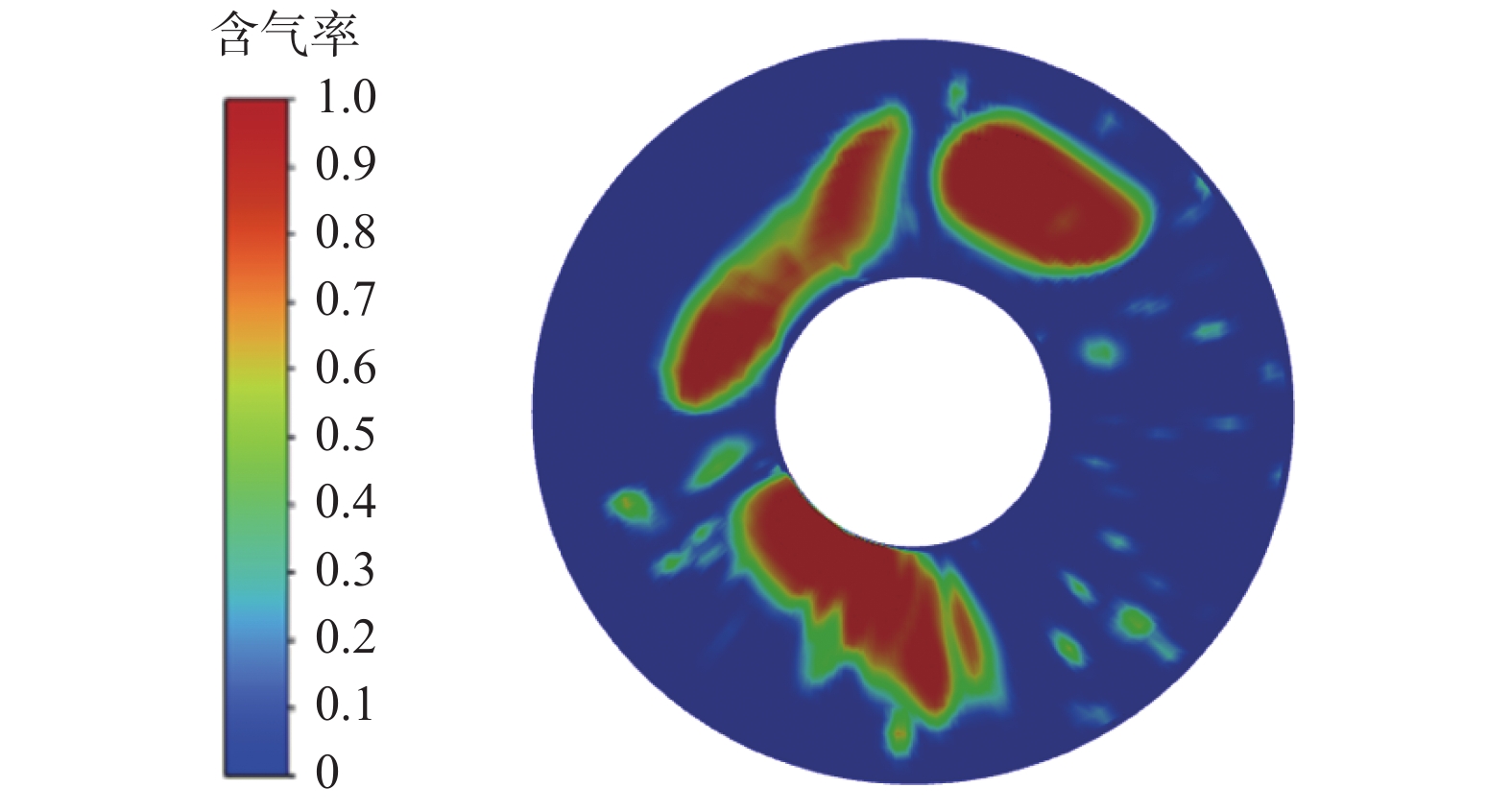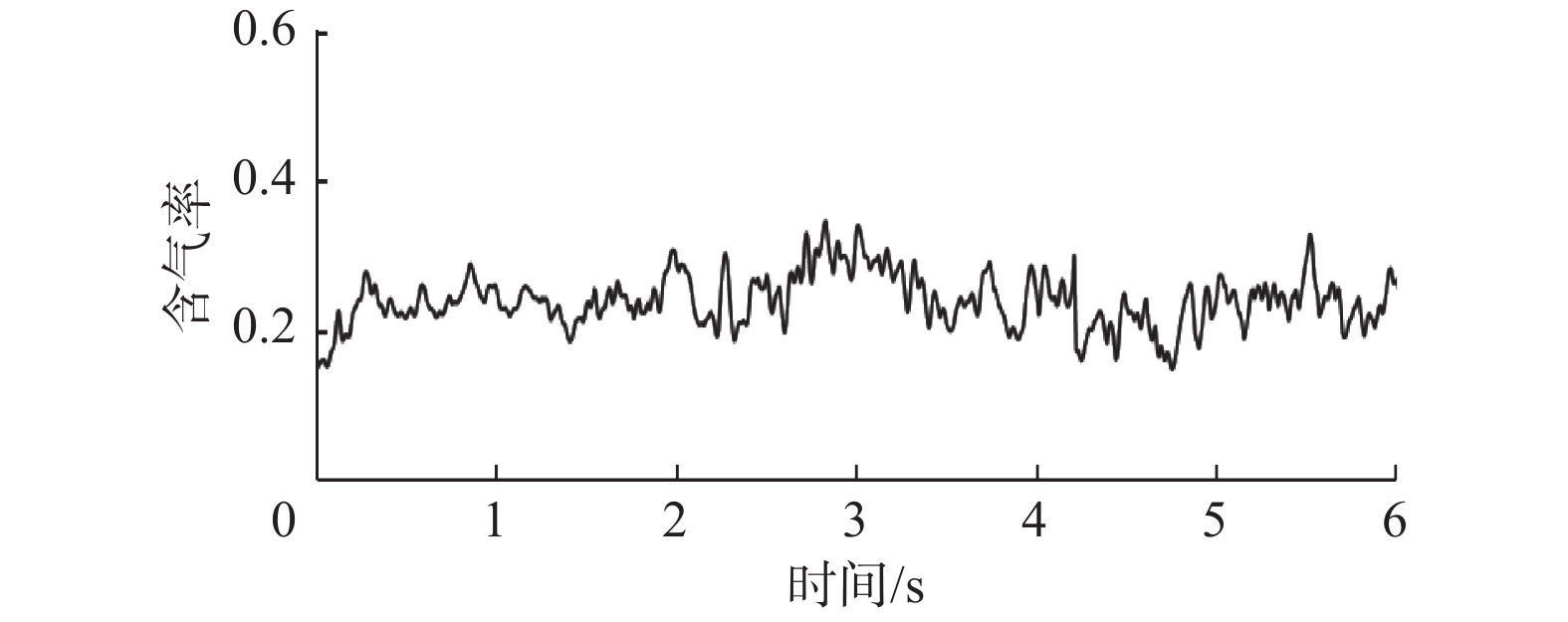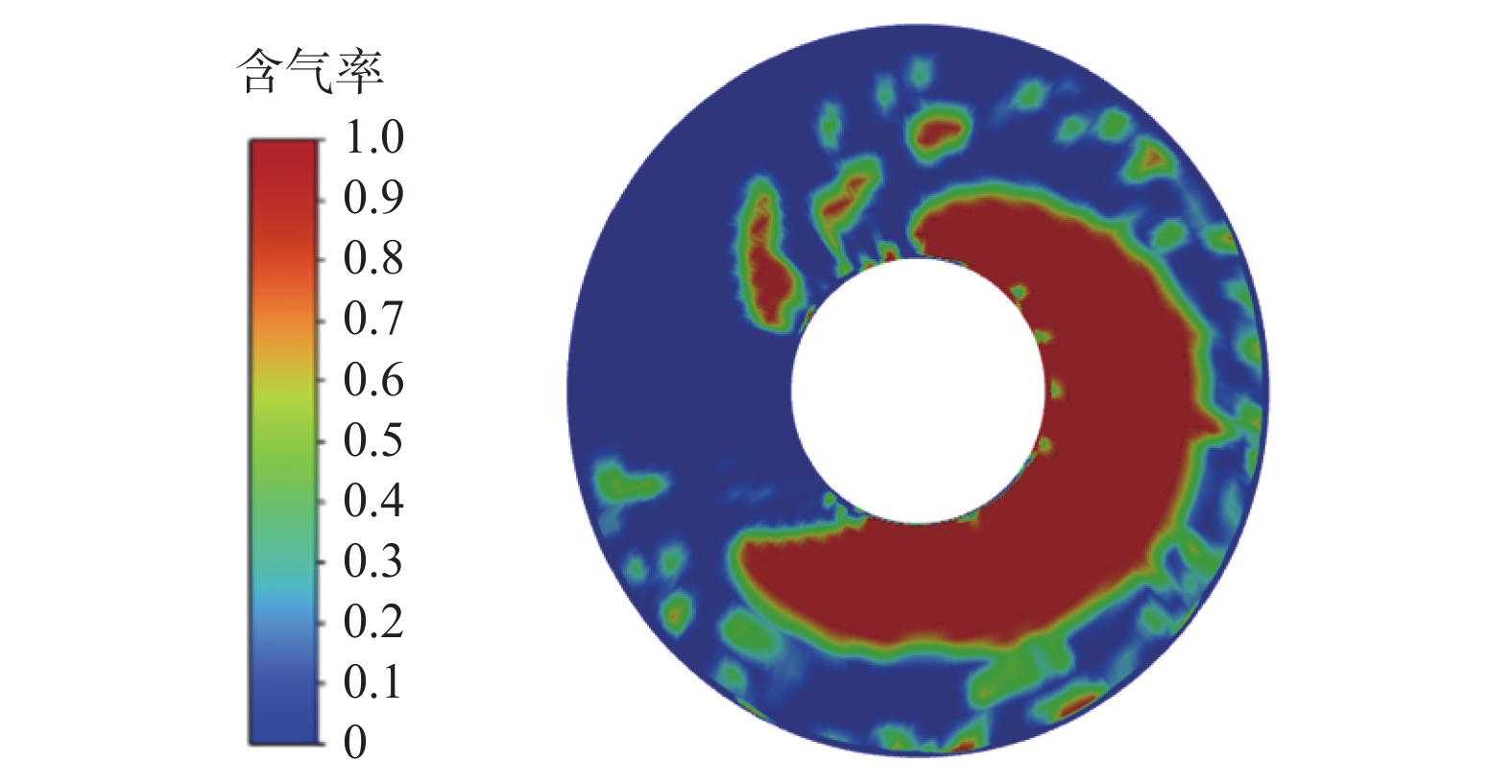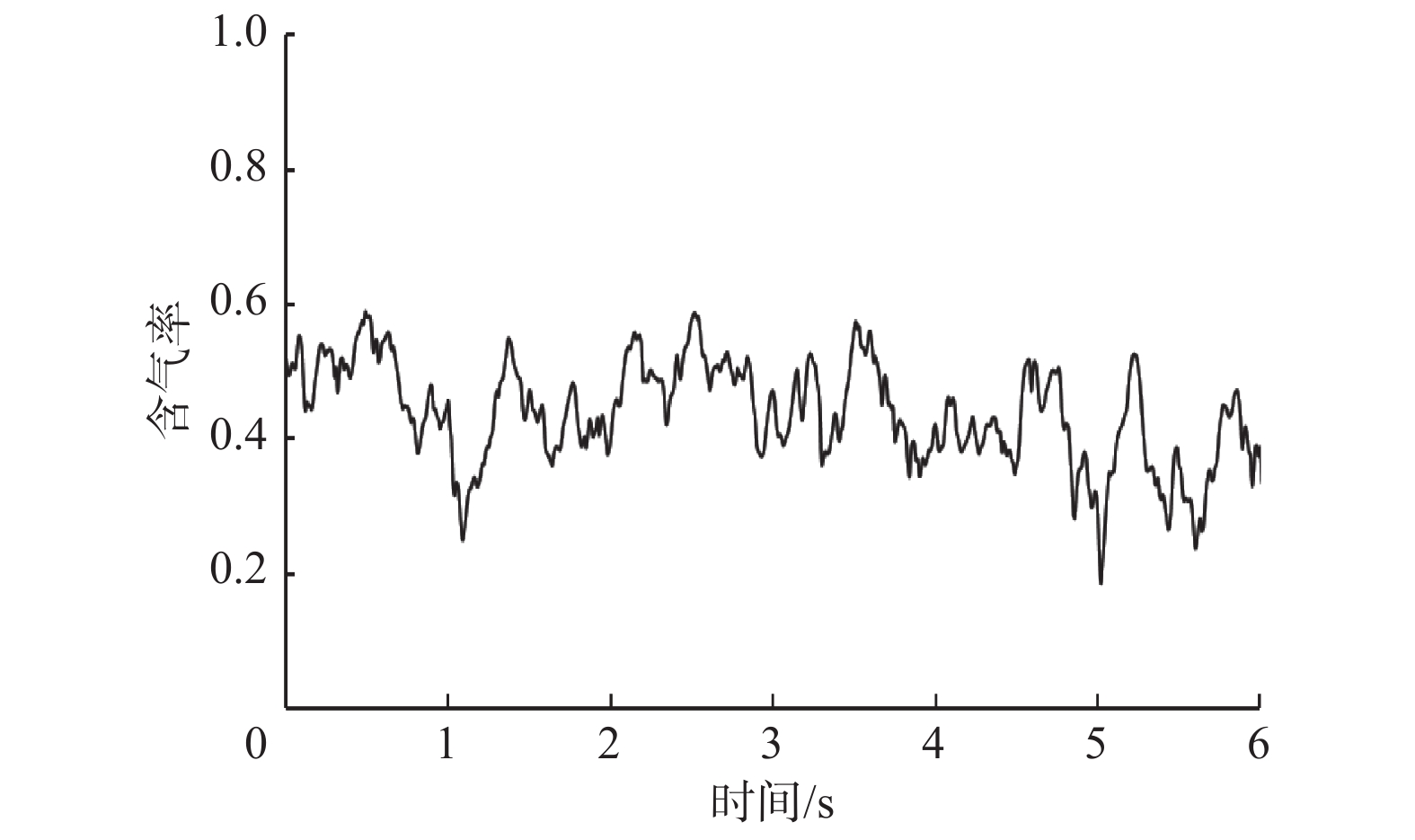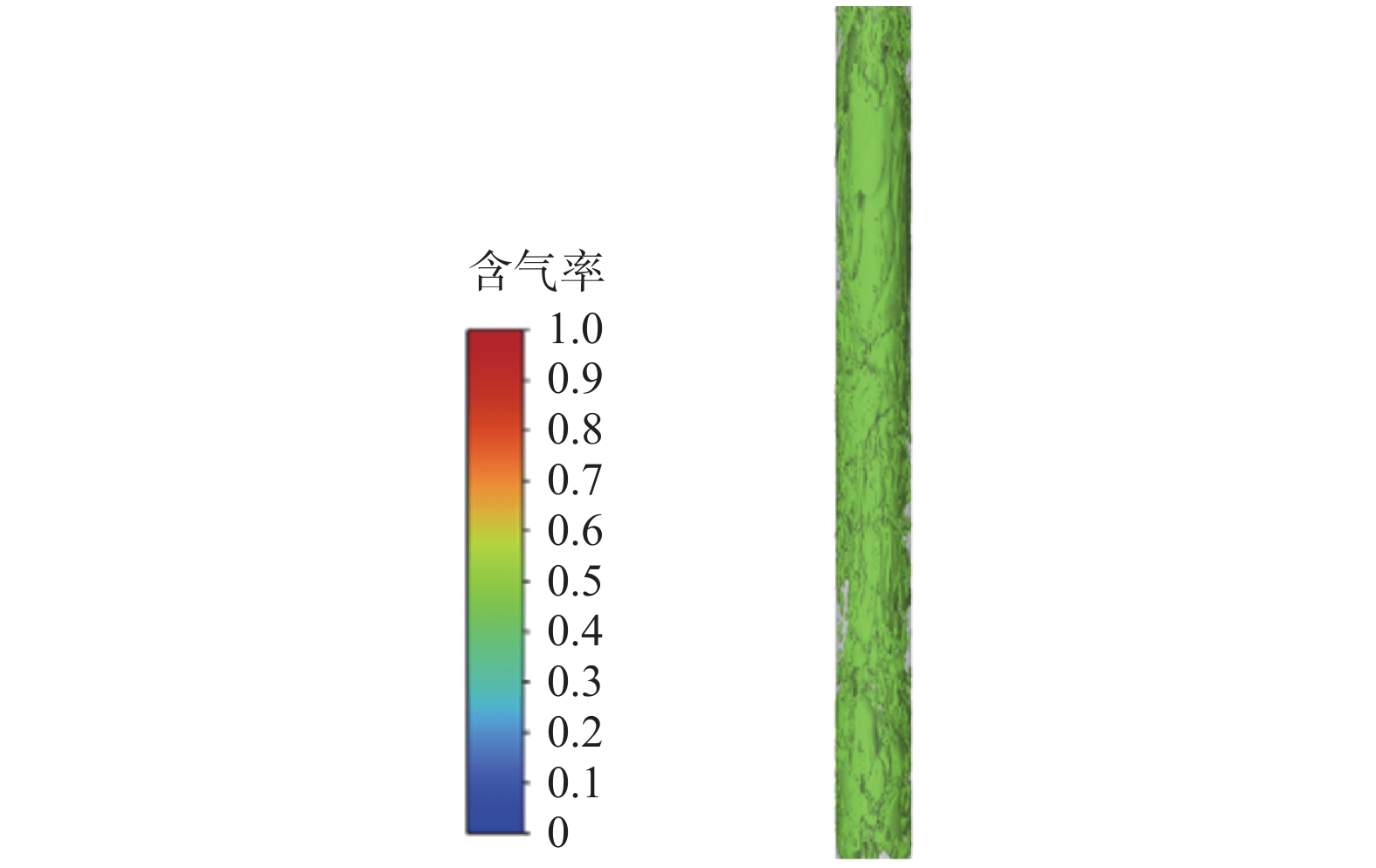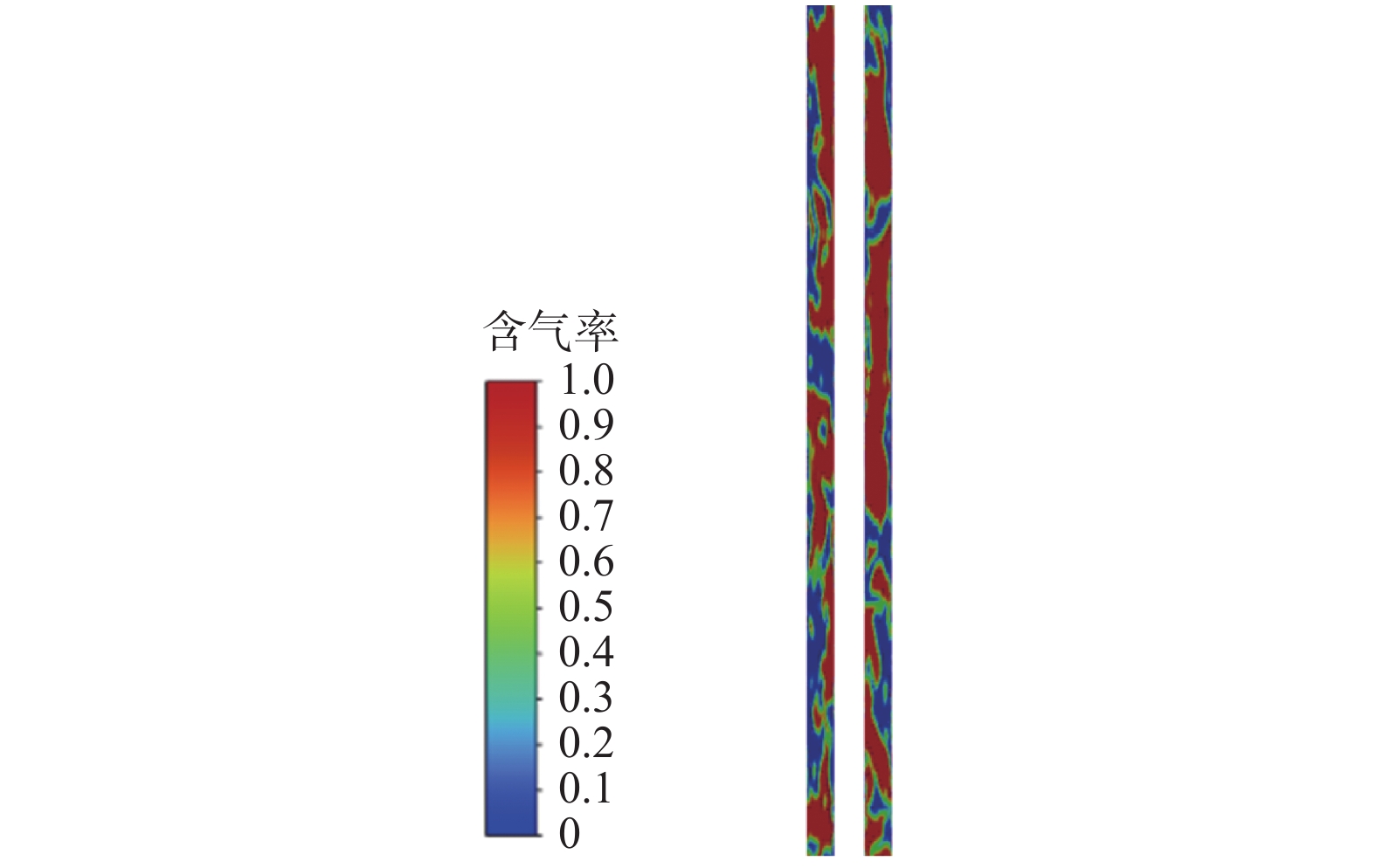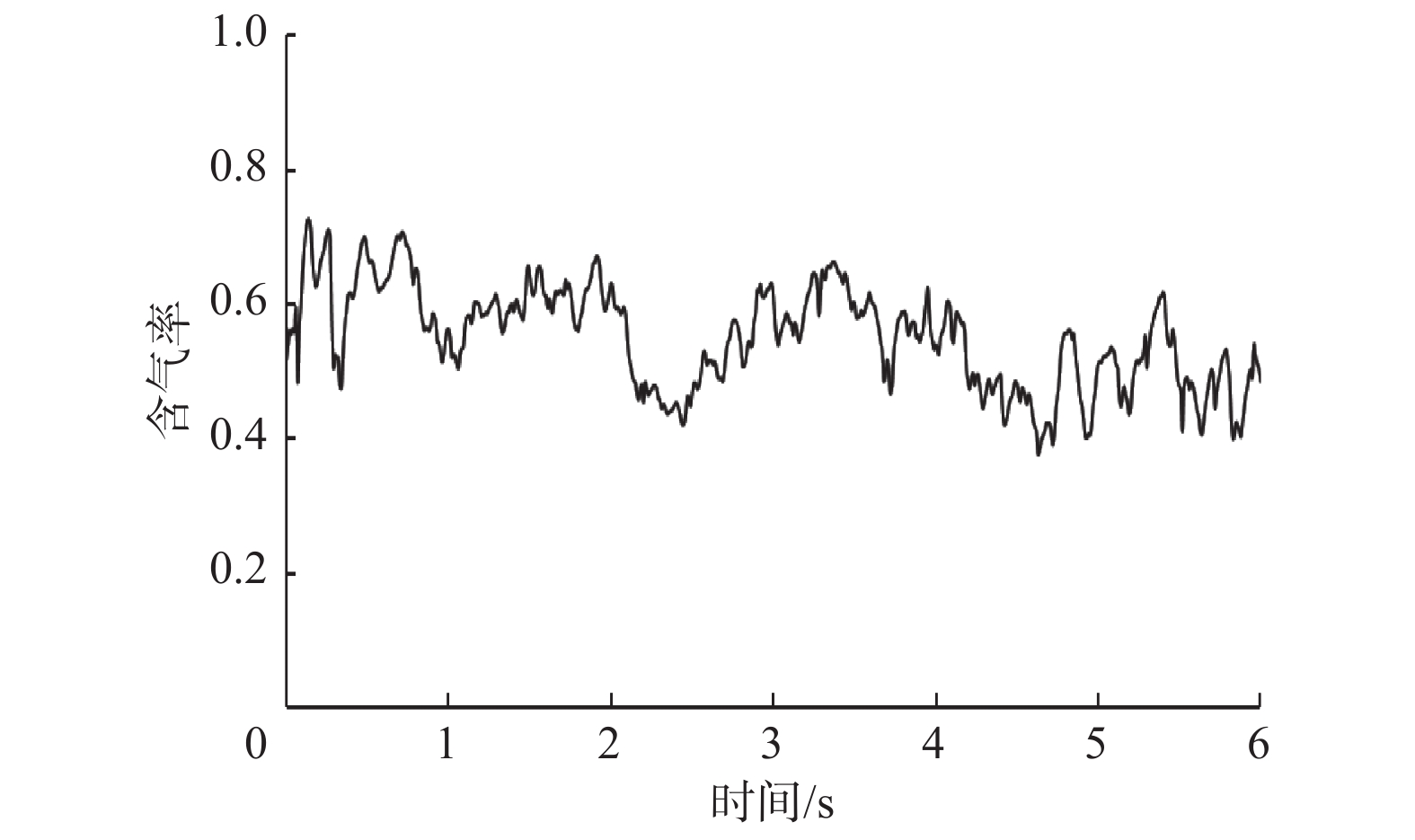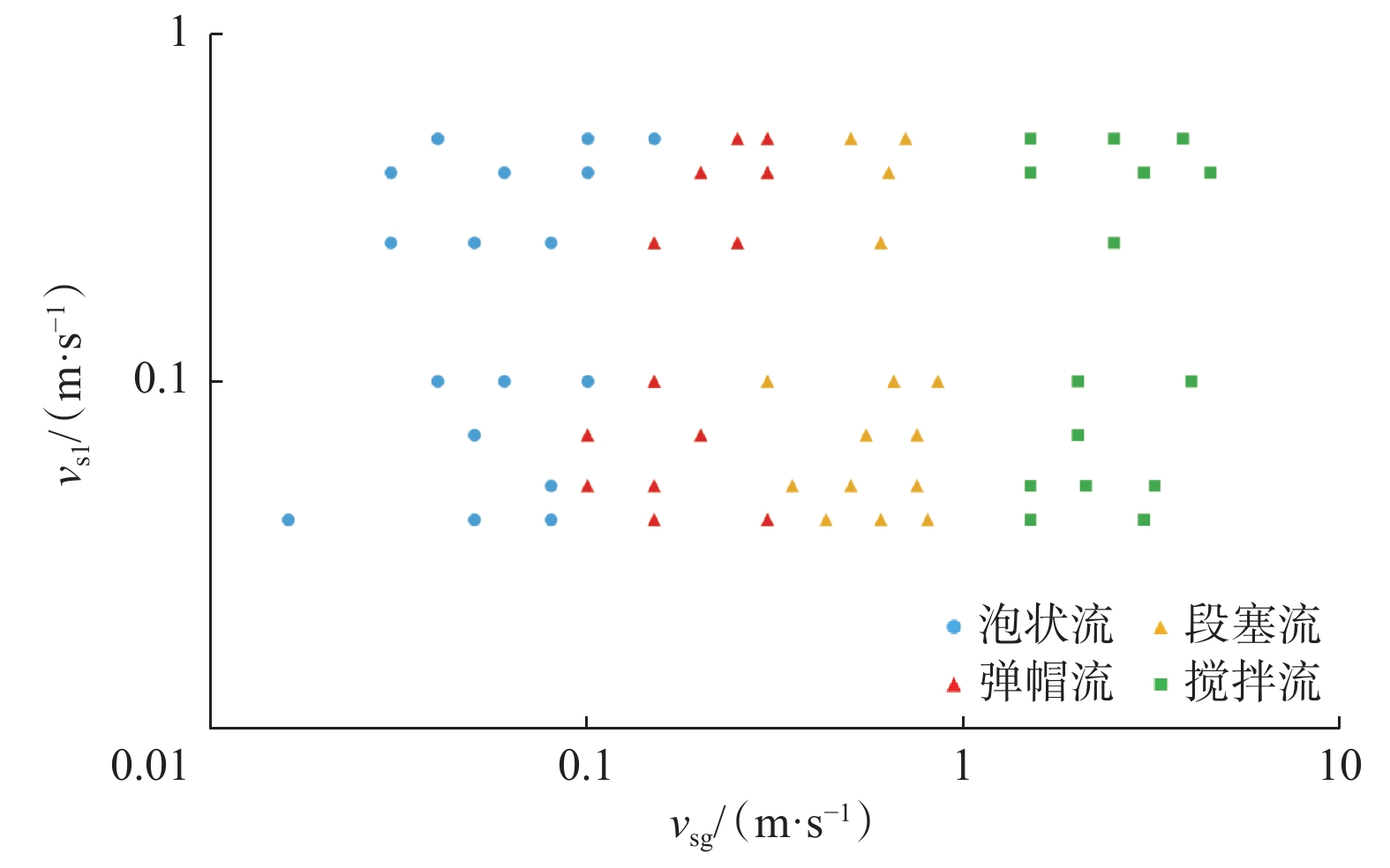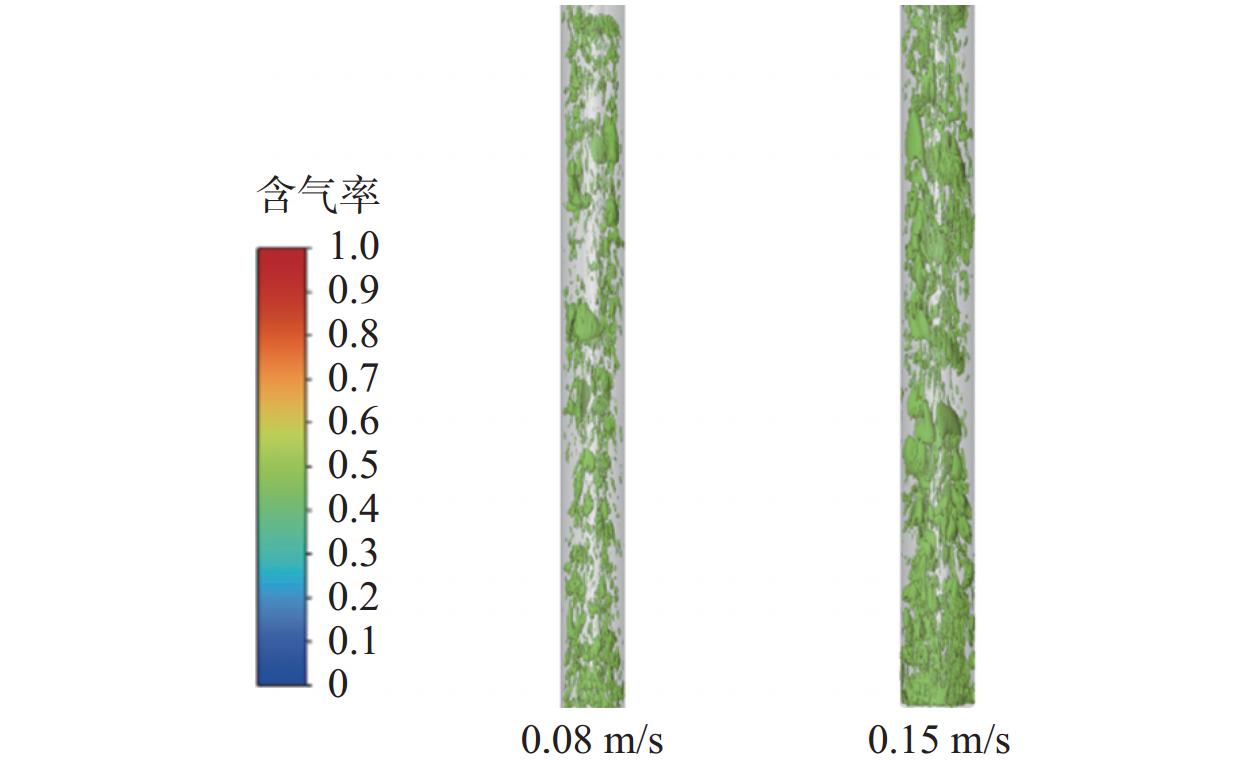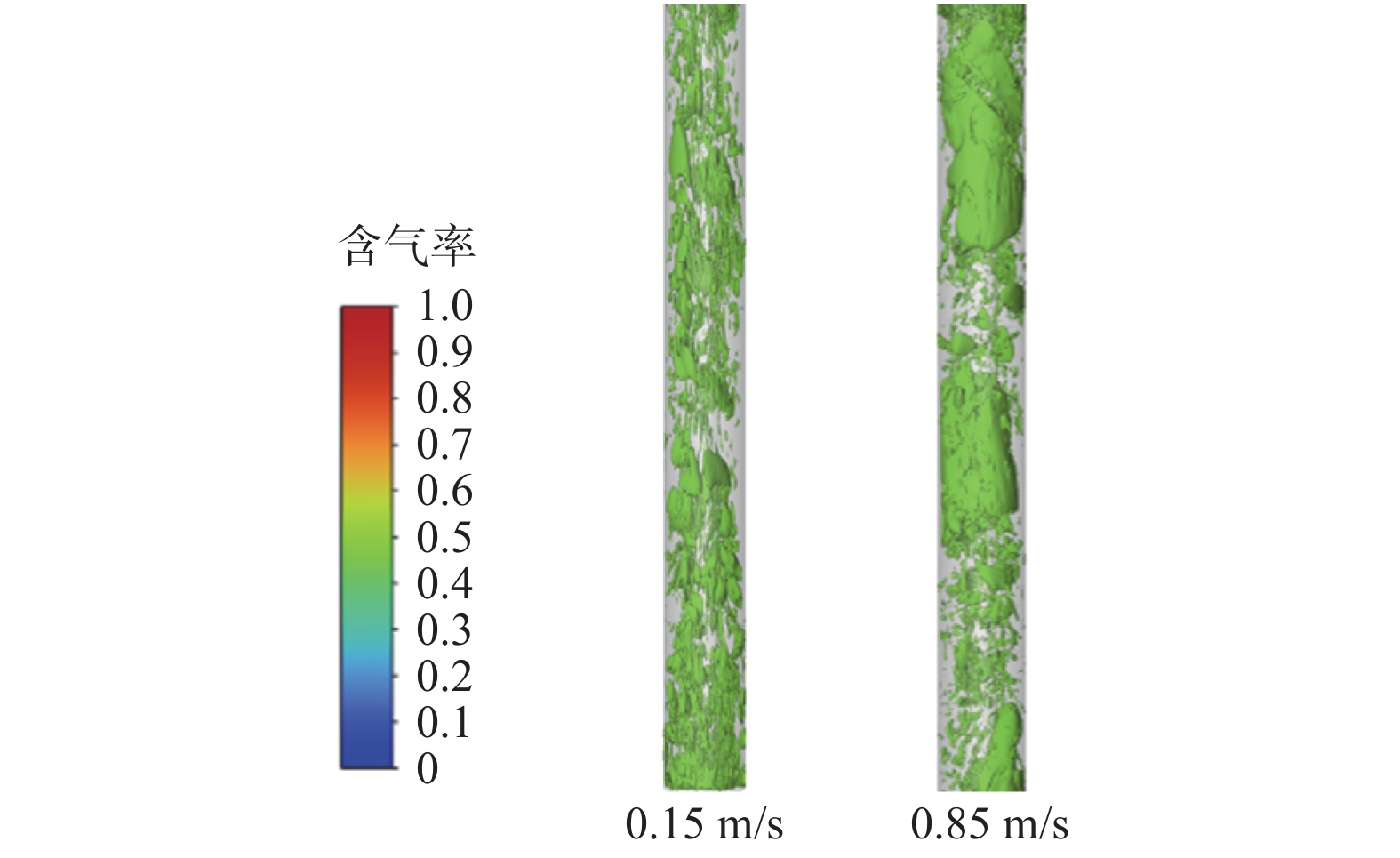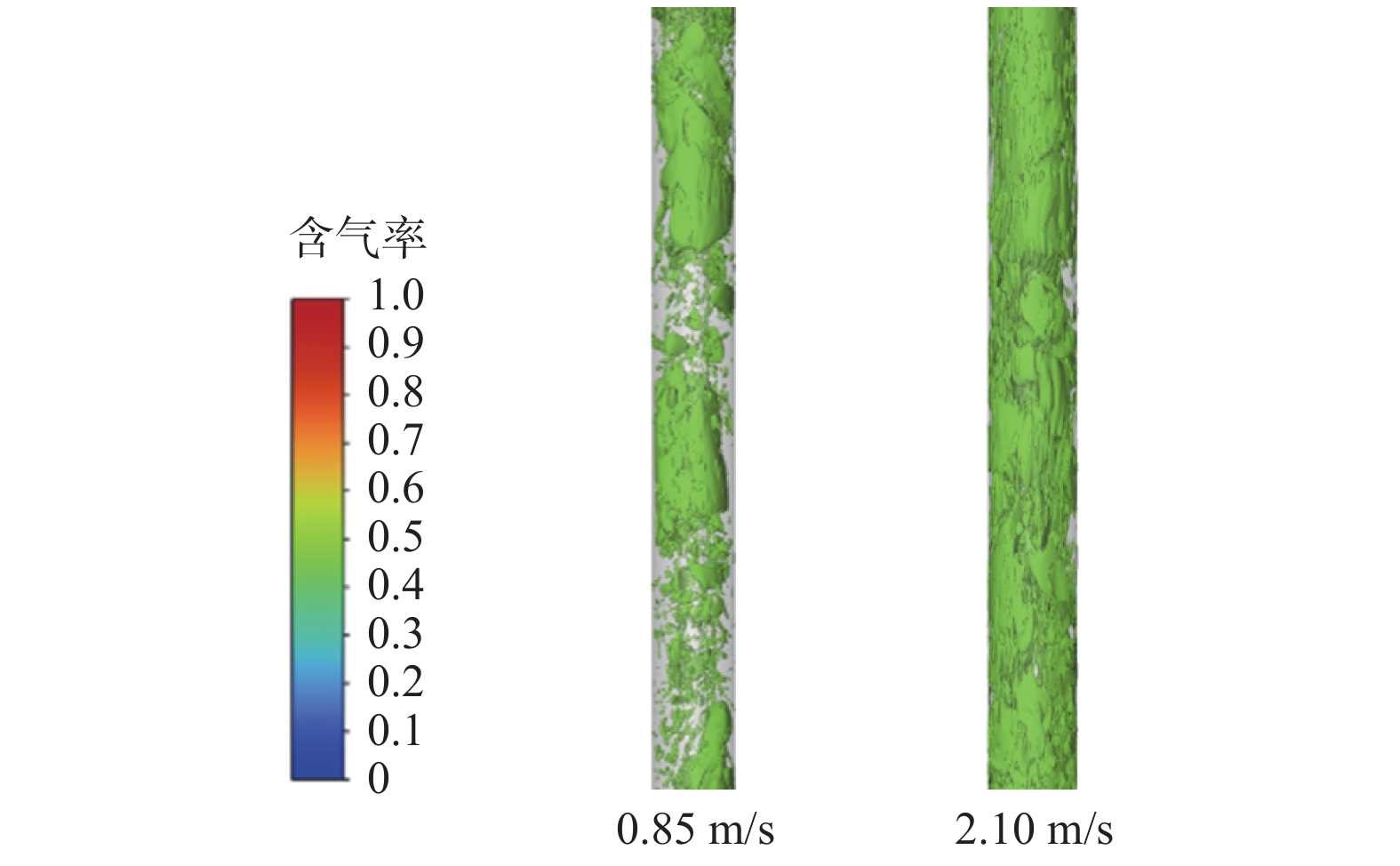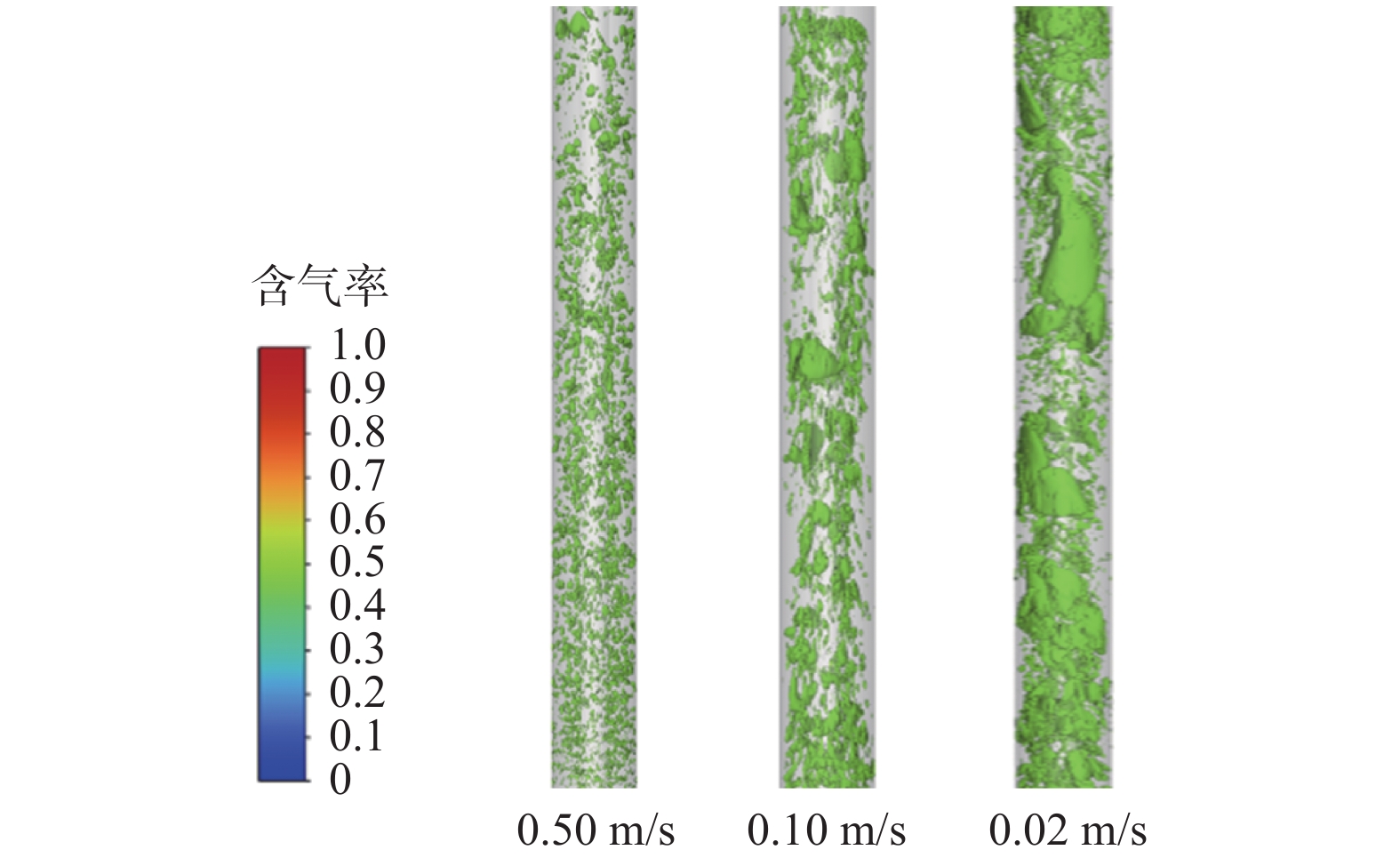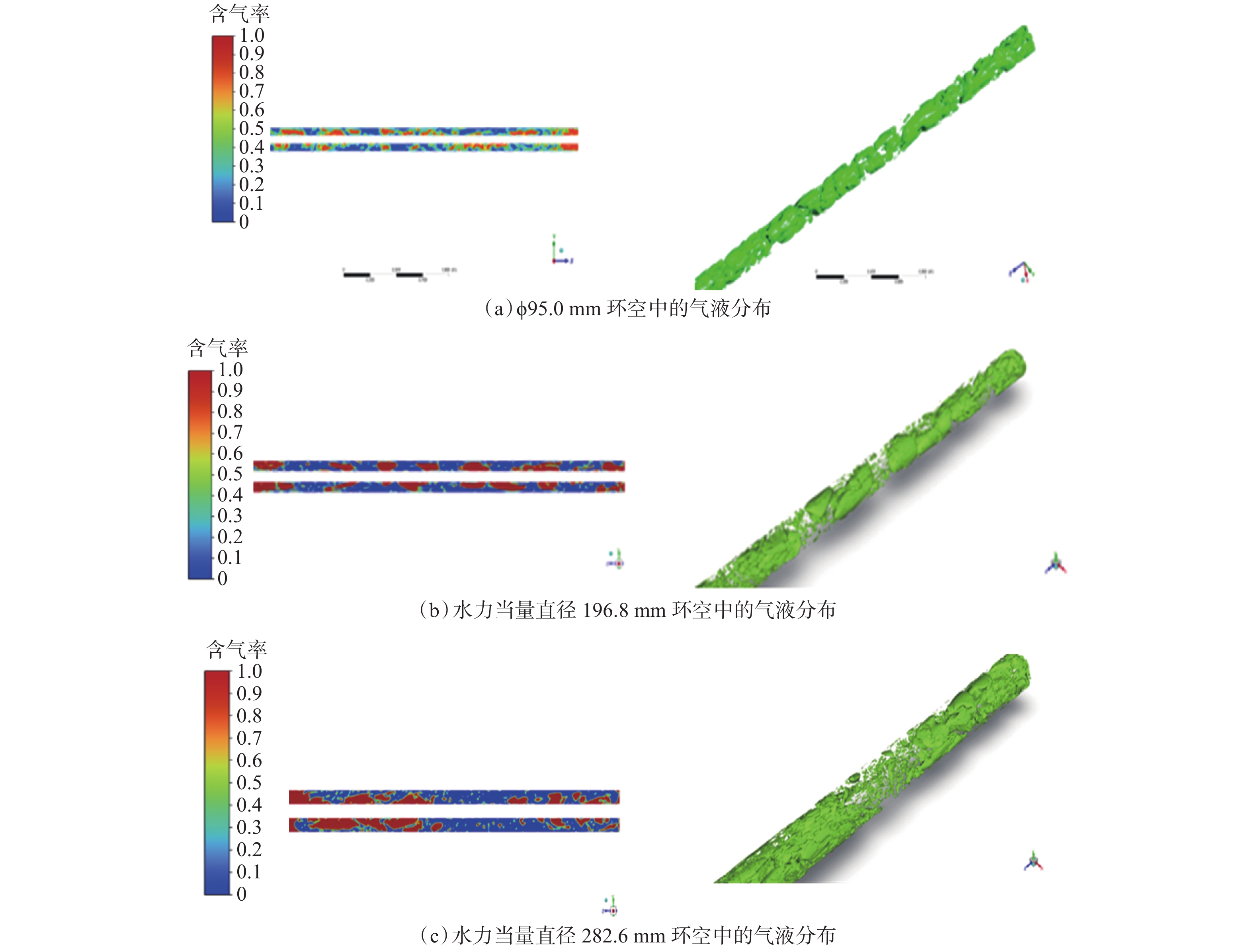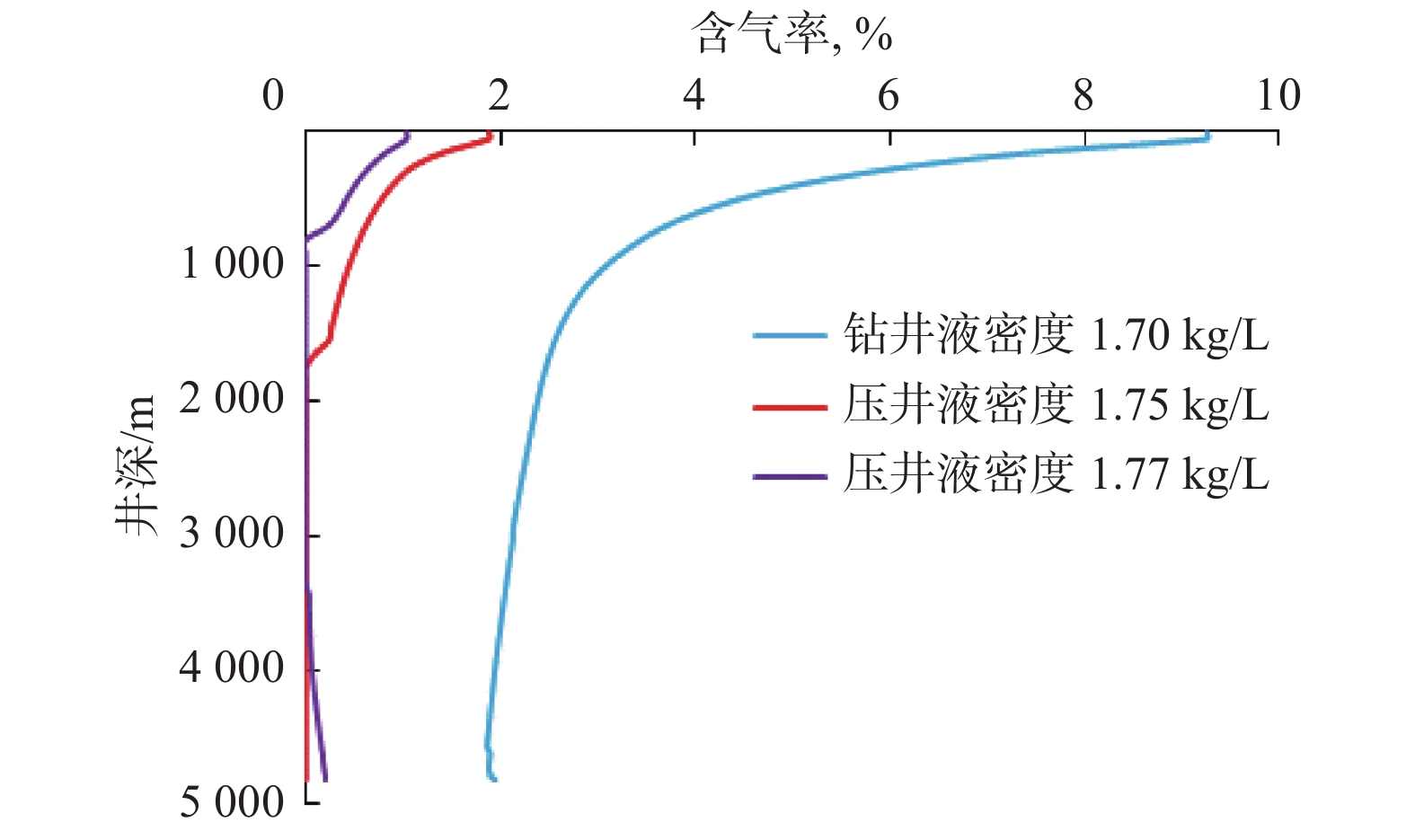Numerical Simulation of Gas-Liquid Two-Phase Flow Pattern in Large Annulus of Deep Well
-
摘要:
深层和超深层油气井井身结构复杂且部分井眼尺寸较大,钻进过程中容易遇到异常压力,导致安全作业窗口变窄。当发生气侵时,井筒环空内会形成气液两相流,传统的基于常规尺寸流型转化理论的压井方法容易超出窄窗口,导致涌漏交替,从而错过最佳压井时机。为解决这一问题,基于VOF模型开发了一种适用于大尺寸环空气液两相流动的数值模拟方法,并采用文献数据验证了其准确性。在水力当量直径196.8 mm环空内进行的气液两相流动模拟中,识别出泡状流、弹帽流、段塞流和搅拌流等4种流型,分析了其特征,并据此绘制了气液两相流流型图,建立了流型转化判据,揭示了环空尺寸对流型转化的影响规律。研究结果表明,与常规尺寸环空相比,大尺寸环空中泡状流的范围扩大,且在泡状流与段塞流之间存在过渡流型——弹帽流,各流型转化边界均有不同程度的右移。由于常规尺寸环空更容易发生气泡聚并形成泰勒泡,压井操作困难,因此,根据常规尺寸环空流型转化判据为大尺寸环空设计的压井参数往往偏大。相比之下,基于新判据设计的压井参数能够更好地适应窄窗口和大尺寸井眼的压井需求,提高了压井的效率和安全性。
Abstract:In deep and ultra-deep oil and gas wells, abnormal pressure is often encountered while drilling due to their complex casing program and larger borehole sizes, which results in a narrowed safe operating window. When gas intrusion occurs, a gas-liquid two-phase flow forms in the annulus of the wellbore. Conventional well killing methods based on flow pattern transition theories of conventional annulus sizes are prone to exceeding this narrow window, leading to alternating influx and loss and therefore the optimal well killing timing is missed. To address this issue, a numerical simulation method for gas-liquid two-phase flow in large-size annulus was developed using the volume of fluid (VOF) model and was verified with literature data for accuracy. In the simulation of gas-liquid two-phase flow in an annulus with a hydraulic equivalent diameter of 196.8 mm, four flow patterns including bubble flow, cap bubble flow, slug flow, and churn flow were identified and analyzed. A gas-liquid flow pattern map was created, and criteria for flow pattern transitions were established, revealing the influence of annulus size on flow pattern transitions. The results indicate that compared with conventional annulus size, the range of bubble flow expands in larger annuli, with a transitional flow pattern, namely cap bubble flow occurring between bubble and slug flows. The boundaries for flow pattern transitions shift to the right to some certain degree. In conventional annulus size, bubble coalescence and the formation of Taylor bubbles are common, making well killing operations more challenging. Consequently, well control parameters designed for large annuli tend to be bigger. On the contrary, the well control parameters designed based on the new criteria meet the requirements of well killing better in narrow windows and large borehole sizes, thereby improving the efficiency and safety of well killing operations.
-
随着生产时间增长,油水井近井筒附近渗流通道会出现堵塞,对注水井而言,注水压力会逐年升高,常规酸化解堵频次增加,且注水效果越来越差,作业成本逐年增加;对油井而言,井底流压升高,油井产量降低。物理解堵、化学解堵和生物解堵等常规解堵方法虽具有一定解堵效果[1-7],但均存在一定不足:多数物理解堵方法施工工艺复杂;化学解堵方法成本高,有效期短,易对油井造成二次伤害,环境污染问题严重;生物解堵方法对环境要求很高,技术不够成熟。为此,国内外开展了一系列增渗解堵新技术研究,其中,井下电爆冲击波解堵技术是利用液电效应产生的强大冲击波,在地层中形成定向传播的压力脉冲,对地层及孔隙内各种介质产生较强的冲击振动,从而解除堵塞,并产生微裂缝,达到解堵、増注的目的,具有广阔的应用前景[8]。
笔者在分析电爆冲击波增渗解堵机理的基础上,开展了电爆冲击波压力峰值影响因素的分析试验、冲击波造缝以及解堵效果评价的室内试验,验证了井下电爆冲击波增渗解堵技术的可行性,为该技术的快速发展及现场试验奠定了基础。
1. 电爆冲击波增渗解堵技术原理
1.1 电爆冲击波作用机制
电爆冲击波增渗解堵技术原理如图1所示,主要包括造缝和解堵2个方面。
1)冲击波造缝作用。与静态力作用相比,岩石在冲击力作用下的断裂疲劳强度要小得多,冲击波使地层岩石受到拉伸及剪切应力,导致地层原始裂纹扩展并产生新的微裂缝,从而扩展原油渗流通道,提高油井产量。
2)冲击波解堵作用。地层岩石为非均匀介质,当冲击波在地层中传播时,由于不同介质的波阻抗不同,在其界面处会产生剪切应力,有助于剥离渗流通道内的堵塞物。另外,冲击波传播过程中对孔隙进行推挤和抽汲作用,有助于将孔隙杂质排除,起到解堵作用[9]。
1.2 电爆冲击波产生机理
电爆冲击波产生机理类似于经典的“液电效应”原理,当储能电容充满电后,放电电路如图2所示。其中,电容储存能量可以通过电容和电压(通常可以达到20 kV以上)求得:
W=0.5CUc2 (1) 式中:W为电容储存能量,J;C为电容器的电容,μF;Uc为电容电压,V。
放电电路的放电端采用金属丝引弧的方式,可以提高能量利用效率,放电开关S闭合的瞬间高电压作用于金属丝,金属丝瞬间通过极大电流,相当于电容储存的能量瞬间转移到放电端的金属丝上,使金属丝瞬间融化并形成等离子体放电通道,周围的水介质在极短的时间内汽化而产生大量热能,从而产生压力冲击波并迅速向外膨胀[10-12]。
金属丝放电过程应满足如下方程:
LcCd2Ucdt2+(Rc+Rw)CdUcdt+Uc=0 (2) 式中:Lc电容器的电感,H;
Rw 为金属丝的时变电阻,Ω;Rc为电容器的电阻,Ω;t为放电时间,s。金属丝放电过程中释放的能量主要包括金属丝沉积能量Ec和电弧产生的能量Ed,分别可以表示为:
Ec=∫t0I(t)Rdt (3) Ed=∫tt1I(t)U(t)dt (4) 式中:Ec为金属丝沉积能量,J;t1为能量沉积时间,即从放电初始到金属丝变为气体状态的时间,s;I(t)为电路中电流,A;R为金属丝电阻,Ω;Ed为电弧产生的能量,J;U(t)为电弧处电压,V。
由于放电过程不稳定,冲击波在形成和传播过程中波尾能量逐渐向波头聚集,从微观上研究冲击波的形成机理和得到定量的物理模型是困难的。然而当冲击波传播一定距离演化为球面波之后,能量沉积密度对冲击波的特性影响不大,可以认为冲击波的压力峰值ppeak与放电参数的关系呈幂指数的形式,其经验计算公式为[13]:
ppeak=β√ρWpτtd (5) 式中:
β 为复杂积分函数,对于水为电介质,可取0.7;ρ 为电介质的密度,kg/m3;Wp为放电通道单位长度的脉冲总能量,J;τ为冲击波上升持续时间,s;td为冲击波总持续时间,s。根据式(5)可知,改变放电能量、冲击波上升持续时间和冲击波总持续时间,可以调节冲击波压力峰值。
2. 冲击波压力影响因素试验
大量研究表明,冲击波压力与电容、充电电压及金属丝直径之间关系密切[13-16],为此通过室内试验研究其影响规律。图3为电爆冲击波影响因素试验装置原理图,其中T1为变压器,P1为10 kV高压直流电源,RX1、X为控制充电速度的绕线电阻,C1为40 μF脉冲储能电容,R1为电路阻抗,KDIA为自制电子开关,CTA为自制电流互感器。
试验时,通过控制面板设定参数,为储能电容充电,达到设定的电压参数时触发电子开关,电能传输到金属丝上,完成放电过程。用示波器采集压力传感器处的压力信号,采用自制的电流线圈和电压差分头测量得到电流电压的波形。
2.1 充电电压
设定金属丝直径为0.30 mm,电容为50 μF,测量充电电压分别为1.0,1.5,2.0,2.5,3.0和3.5 kV时的冲击波压力峰值,结果见图4。由图4可以看出,随着充电电压增大,冲击波压力峰值基本成线性增大。这是由于充电电压与电容器储能量直接相关,充电电压越大,电容器储能量就越大,注入金属丝的电爆能量也越大,产生的冲击波压力峰值越大。在实际应用中,可以通过提高充电电压获得更高的冲击波压力峰值,以达到更好的增渗解堵效果,这也是实现冲击波可控的重要手段。
2.2 金属丝直径
设定充电电压为3 kV,电容为50 μF,测量金属丝直径分别为0.15,0.20,0.30,0.06,0.90和1.00 mm时的冲击波压力峰值,结果见图5。由图5可以看出,随着金属丝直径增大,冲击波压力峰值基本稳定在1.1 MPa左右,可见,金属丝直径对冲击波压力峰值影响不大。这是由于金属丝直径直接影响金属丝电阻,而金属丝电阻与电路电阻共同影响放电电流,进而影响电爆能量。在设置的试验放电参数下,金属丝电阻相对较小,对放电电流影响较小,所以对冲击波压力峰值影响不大。
2.3 电容
设定充电电压为3 kV,金属丝直径为0.30 mm,测量电容分别为10,20,30,40和50 μF时的冲击波压力峰值,结果见图6。由图6可以看出,电容为20 μF时,冲击波压力峰值达到最大,然后随着电容增大开始下降。这是由于随着电容增大,电容器储能量增大,压力峰值会随着增大,但同时电容增大会增大电路电阻,使放电电流变小,进而导致冲击波压力峰值降低,因此,在实际应用中,要根据具体情况选择最优电容。
3. 冲击波造缝试验
为验证电爆冲击波的地层造缝作用,选取了与目标砂岩地层物理性质类似的C30混凝土试样(直径为500 mm,高为500 mm),并在试样上钻一直径130 mm、深300 mm的孔,利用冲击波试验装置(见图3)进行不同能量冲击波造缝试验。试验时,孔中灌满水作为电介质,将放电电极置于孔中,设置电容为9 μF,充电电压在0~30 kV可调,根据式(1),电容储能最大为4.05 kJ。
试验结果表明,放电电压为30 kV时,产生的压力冲击波可以对混凝土试样造成贯穿裂缝,如图7所示。第1次冲击后,测量得到的裂缝渗透流量为0.27 mL/s,连续冲击2次、3次后的裂缝渗透流量分别增加至3.06和28.00 mL/s。电爆冲击波多次作用后,混凝土试样表面出现明显裂缝,并且随着冲击次数的增多,混凝土试样的渗透率显著增大。
电爆冲击波造缝试验结果初步验证了电爆冲击波对砂岩储层造缝增产的可行性,不同储层可以选取不同的放电参数,以获得适用于不同储层物性的可控冲击波。
4. 解堵效果评价试验
4.1 试验装置
为验证电爆冲击波的解堵效果,研制了电爆冲击波解堵试验室内评价装置(见图8),通过串联岩心夹持器,可以模拟近井壁直径1.00 m内的地层渗透效果,还可对岩心施加围压,模拟井下压力环境进行电爆冲击波解堵试验。
试验装置中各部分的主要参数及功能为:
1)采用电爆压力罐模拟井筒环境。电爆压力罐内径150 mm,深度400 mm,罐体中部配有加注阀口,用于注入水,顶部为电极插入口。罐体安装有压力传感器,用于测量电爆过程中的冲击波瞬时压力;压力控制阀1控制电爆压力罐的压力,当压力大于设定压力时,电爆压力罐内的液体会通过压力控制阀溢流到流量计量装置。
2)岩心夹持器外套连接围压加载阀,外套内部配有胶套,通过围压加载阀向胶套与外套之间的空间注水,模拟地层压力环境;岩心夹持器连接有围压和轴压传感器,用于监测加载围压和岩心轴向的渗透压力。
3)供液压力罐可通过压力控制阀2向岩心注水,水渗透岩心后进入电爆压力罐,具有恒压、恒流2种工作模式。
4)流量计量装置可根据设定的时间间隔记录流入液体的质量,求得瞬时流量和累计流量。流量计量装置底部有阀门连接到储液箱,每次试验完毕,可将水通过阀门排至储液箱。
4.2 试验流程
1)试验开始时,通过注流泵向供液压力罐注水,供液压力罐向电爆压力罐注水并加压至2.0 MPa,向岩心夹持器胶套与外套之间的空间注水加压至4.0 MPa。
2)启动电爆冲击波设备,设置充电电压30 kV,储能4.05 kJ。电爆压力罐内产生冲击波作用于岩心,压力传感器监测冲击波压力。
3)水在轴压的作用下渗透穿过岩心,流向电爆压力罐,当电爆罐压力超过压力控制阀1设定的初始压力时,电爆压力罐内的水会流入流量计量装置,获得岩心渗透流量。
4)试验完毕后将流量计量装置中的水排空,再次进行电爆冲击,重复上述操作进行多次试验,测试多次电爆冲击波作用后岩心的渗透率变化情况。
4.3 试验结果分析
岩心累计渗透流量试验结果如图9所示。由图9可以看出:累计流量随时间呈抛物线增长,开始时增长速度较快,最后趋于平缓;冲击波作用4次后岩心平均渗流量达到0.064 mL/min,与试验前岩心的平均渗流量0.040 mL/min相比,平均渗流量提高了60.0%,表明电爆冲击波对岩心产生了良好的解堵增渗效果,验证了在井下围压条件下电爆冲击波增渗解堵的可行性。
5. 结论与建议
1)电爆冲击波可以在地层流体介质中形成定向传播的压力脉冲,不但能使储层产生微裂缝,而且对堵塞杂质具有抽汲作用,可以获得解堵增渗的效果。
2)室内试验表明,随着充电电压增大,冲击波压力峰值呈线性增长,金属丝直径对冲击波压力峰值影响不大,电容对冲击波压力峰值的影响有一个最优值,要根据具体情况选择最优电容。
3)室内试验结果验证了电爆冲击波可以扩展储层岩石的裂缝并产生新的微裂缝,而且在井下围压条件下能达到增渗解堵的效果。
4)由于采用的试验岩心较为致密,渗透时间较长,试验初期的电爆冲击波能量也较小,导致增渗效果还不是非常明显,在后期试验研究中需要进一步改进和优化。
-
表 1 数值模型流体的物性参数
Table 1 Physical properties parameters of fluid for numerical simulation
流体 密度/(kg·m−3) 黏度/(mPa·s) 表面张力/(N·m−1) 水 998.2 1.003 0.072 空气 1.225 1.798×10−2 表 2 不同工况下的数值模拟结果与试验结果
Table 2 Comparison between numerical simulation results and experimental data under different workingconditions
工况 气相表观
速度/(m·s−1)液相表观
速度/(m·s−1)数值模拟流型 试验流型 a 0.125 0.025 泡状流 泡状流 b 0.150 0.030 泡状流 泡状流 c 0.150 0.100 弹帽流 弹帽流 d 1.000 0.030 搅拌流 搅拌流 表 3 液相表观流速为0.05 m/s时,不同气相表观流速下流型模拟结果
Table 3 Flow pattern simulation results under different apparent gas-phase flow velocities when apparent liquid-phase flow velocity is 0.05 m/s
液相表观速度/(m·s−1) 气相表观速度/(m·s−1) 数值模拟流型 0.05 0.08 泡状流 0.15 弹帽流 0.85 段塞流 2.10 搅拌流 表 4 气相表观流速为0.15 m/s时,不同液相表观流速下流型模拟结果
Table 4 Flow pattern simulation results under different apparent liquid-phase flow velocities when apparent gas-phase flow velocity is 0.15 m/s
气相表观速度/(m·s−1) 液相表观速度/(m·s−1) 数值模拟流型 0.15 0.50 泡状流 0.10 弹帽流 0.02 段塞流 -
[1] SADATOMI M, SATO Y, SARUWATARI S. Two-phase flow in vertical noncircular channels[J]. International Journal of Multiphase Flow, 1982, 8(6): 641–655. doi: 10.1016/0301-9322(82)90068-4
[2] KELESSIDIS V C, DUKLER A E. Modeling flow pattern transitions for upward gas-liquid flow in vertical concentric and eccentric annuli[J]. International Journal of Multiphase Flow, 1989, 15(2): 173–191.
[3] 陈家琅,石在虹,许剑锋. 垂直环空中气液两相向上流动的流型分布[J]. 大庆石油学院学报,1994,18(4):23–26. CHEN Jialang, SHI Zaihong, XU Jianfeng. Flow patterns of gas-liquid two-phase upward flow in vertical annuli[J]. Journal of Daqing Petroleum Institute, 1994, 18(4): 23–26.
[4] 林英松,陈庭根,李相方. 垂直环空气液两相流流型的实验研究[J]. 石油大学学报(自然科学版),1996,20(3):29–31. LIN Yingsong, CHEN Tinggen, LI Xiangfang. Experimental study of gas-liquid two-phase flow in vertical annular space[J]. Journal of the University of Petroleum, China(Edition of Natural Science), 1996, 20(3): 29–31.
[5] 张军,陈听宽,金友煌. 环空管内气液两相流流型研究进展[J]. 油气井测试,1999,8(4):63–68. ZHANG Jun, CHEN Tingkuan, JIN Youhuang. The progress of studies on flow pattern of gas-liquid two phase flow in the annulus[J]. Well Testing, 1999, 8(4): 63–68.
[6] ISSA R I. Prediction of turbulent, stratified, two-phase flow in inclined pipes and channels[J]. International Journal of Multiphase Flow, 1988, 14(2): 141–154. doi: 10.1016/0301-9322(88)90002-X
[7] NEWTON C H, BEHNIA M. Numerical calculation of turbulent stratified gas–liquid pipe flows[J]. International Journal of Multiphase Flow, 2000, 26(2): 327–337. doi: 10.1016/S0301-9322(99)00010-5
[8] 赵铎. 水平管内气液两相流流型数值模拟与实验研究[D]. 青岛:中国石油大学(华东),2007. ZHAO Duo. Numerical simulation and experiment research on flow pattern of gas-liquid flow in horizontal pipe[D]. Qingdao: China University of Petroleum(East China), 2007.
[9] 彭壮,廖锐全,汪国琴,等. 高气液流速下垂直管两相流实验及数值模拟研究[J]. 油气田地面工程,2016,35(3):41–44. doi: 10.3969/j.issn.1006-6896.2016.3.013 PENG Zhuang, LIAO Ruiquan, WANG Guoqin, et al. Experimental and numerical simulation study on two phase flow in vertical pipe at high gas-liquid flow rates[J]. Oil-Gas Field Surface Engineering, 2016, 35(3): 41–44. doi: 10.3969/j.issn.1006-6896.2016.3.013
[10] 王海燕,王春升,李玉星,等. 气液两相流流型的判别方法[J]. 油气储运,2019,38(7):772–777. WANG Haiyan, WANG Chunsheng, LI Yuxing, et al. Flow-pattern-prediction models used for gas-liquid two-phase flow[J]. Oil & Gas Storage and Transportation, 2019, 38(7): 772–777.
[11] 张馨玉. 介质、管径及倾角对管内气液两相流型影响的数值模拟[D]. 长春:东北电力大学,2019. ZHANG Xinyu. Numerical simulation on effect of medium, diameter and angle on gas-liquid two-phase flow pattern in tubes[D]. Changchun: Northeast Electric Power University, 2019.
[12] 邱小雪,戴家才,陈猛,等. 基于VOF对低产积液气井流动特征的数值模拟[J]. 断块油气田,2020,27(5):619–623. QIU Xiaoxue, DAI Jiacai, CHEN Meng, et al. Numerical simulation of the flow characteristics in low-yield and liquid loading gas well based on VOF[J]. Fault-Block Oil & Gas Field, 2020, 27(5): 619–623.
[13] 俞强强,施红辉,董若凌,等. 竖直上升圆管内气液两相流流型特性的数值模拟[J]. 浙江理工大学学报(自然科学版),2022,47(3):397–404. YU Qiangqiang, SHI Honghui, DONG Ruoling, et al. Numerical simulation of flow pattern characteristics of gas-liquid two-phase flow in vertical rising pipes[J]. Journal of Zhejiang Sci-Tech University(Natural Sciences), 2022, 47(3): 397–404.
[14] 张旭鑫. 垂直环空油基钻井液-气体两相流流型转化规律研究[D]. 青岛:中国石油大学(华东),2020. ZHANG Xuxin. Study on flow pattern transition of oil based drilling fluid-gas two-phase flow in vertical annulus[D]. Qingdao: China University of Petroleum(East China), 2020.
[15] COLMANETTI A R A, de CASTRO M S, BARBOSA M C, et al. Phase inversion phenomena in vertical three-phase flow: Experimental study on the influence of fluids viscosity, duct geometry and gas flow rate[J]. Chemical Engineering Science, 2018, 189: 245–259.
[16] COLMANETTI A R A, de CASTRO M S, BARBOSA M C, et al. Influence of liquid viscosity and geometry on vertical gas/liquid two-phase annular-duct flow[J]. SPE Journal, 2020, 25(6): 3236–3249. doi: 10.2118/200491-PA
[17] 李昊. 超临界条件下井筒环空多相流动规律研究[D]. 青岛:中国石油大学(华东),2015. LI Hao. Study on multi-phase flow in supercritical wellbore annular[D]. Qingdao: China University of Petroleum(East China), 2015.
[18] GRIFFITH P, SNYDER G A. The bubbly-slug transition in a high velocity two phase flow: technical report No. 5003-29[R]. Cambridge: M. I. T. Division of Sponsored Research, 1964.
[19] RADOVCICH N A, MOISSIS R. The transition from two phase bubble flow to slug flow: report No. 7-7673-22[R]. Cambridge: M. I. T. Division of Sponsored Research, 1962.
[20] HARMATHY T Z. Velocity of large drops and bubbles in media of infinite or restricted extent[J]. AIChE Journal, 1960, 6(2): 281–288. doi: 10.1002/aic.690060222
[21] ZUBER N, FINDLAY J A. Average volumetric concentration in two-phase flow systems[J]. Journal of Heat Transfer, 1965, 87(4): 453–468. doi: 10.1115/1.3689137
[22] TAITEL Y, BARNEA D, DUKLER A E. Modelling flow pattern transitions for steady upward gas-liquid flow in vertical tubes[J]. AIChE Journal, 1980, 26(3): 345–354. doi: 10.1002/aic.690260304
[23] OZAWA M, AKAGAWA K, SAKAGUCHI T. Flow instabilities in parallel-channel flow systems of gas-liquid two-phase mixtures[J]. International Journal of Multiphase Flow, 1989, 15(4): 639–657.
[24] DAS G, DAS P K, PUROHIT N K, et al. Flow pattern transition during gas liquid upflow through vertical concentric annuli: part II: mechanistic models[J]. Journal of Fluids Engineering, 1999, 121(4): 902–907. doi: 10.1115/1.2823553
[25] 孙宝江,王雪瑞,孙小辉,等. 井筒四相流动理论在深水钻完井工程与测试领域的应用与展望[J]. 天然气工业,2020,40(12):95–105. doi: 10.3787/j.issn.1000-0976.2020.12.011 SUN Baojiang, WANG Xuerui, SUN Xiaohui, et al. Application and prospect of the wellbore four-phase flow theory in the field of deepwater drilling and completion engineering and testing[J]. Natural Gas Industry, 2020, 40(12): 95–105. doi: 10.3787/j.issn.1000-0976.2020.12.011
[26] SUN Baojiang, GONG Peibin, WANG Zhiyuan. Simulation of gas kick with high H2S content in deep well[J]. Journal of Hydrodynamics, 2013, 25(2): 264–273. doi: 10.1016/S1001-6058(13)60362-5
-
期刊类型引用(7)
1. 高继开,姜涵钧,王秀龙,张凤鹏,彭建宇. 基于金属丝电爆炸的岩石爆破教学实验平台设计及应用. 实验技术与管理. 2024(11): 146-152 .  百度学术
百度学术
2. 孟向丽,杨淼,黄利平,刘春祥,李旭光. 油井筛管堵塞识别和治理方法. 石油工业技术监督. 2022(04): 7-10 .  百度学术
百度学术
3. 赵树彬,张命俊,路远涛,汤俊萍,汪锋,朱立江,郑永学. 可控冲击波增产技术在大庆油田的应用. 石油管材与仪器. 2022(05): 76-80 .  百度学术
百度学术
4. 阎洪涛,徐文江,于继飞,姜维东,陈欢. 海上疏松砂岩油田注水压力优化方法研究. 中国海上油气. 2021(02): 131-135 .  百度学术
百度学术
5. 王巧智,苏延辉,江安,郑春峰,高波,张云飞. 可控冲击波增渗解堵技术实验研究. 天然气与石油. 2021(02): 68-74 .  百度学术
百度学术
6. 赵景辉,杨万有,郑春峰,李昂,沈琼. 可控冲击波作用下的油井产能模型研究. 重庆科技学院学报(自然科学版). 2021(03): 15-19+48 .  百度学术
百度学术
7. 江海畏,薛启龙. 电爆冲击波对储层致裂效果影响因素的数值模拟研究. 探矿工程(岩土钻掘工程). 2020(11): 70-76 .  百度学术
百度学术
其他类型引用(1)




 下载:
下载:



















